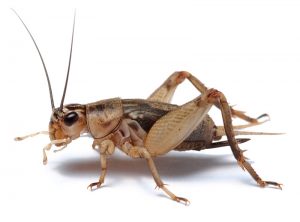CRICKETS, OR "TRUE CRICKETS" ARE RELATED TO GRASSHOPPERS BUT MORE CLOSELY RELATED TO KATYDIDS OR BUSH CRICKETS BECAUSE THEY HAVE SLIGHTLY FLATTENED BODIES AND LONG ANTENNAE.
Male crickets are the only ones that chirp.
They have ridges on their wings that they rub together that act like a comb and file to form an instrument. Their left forewing contains 50-300 teeth that are raised and angled. This wing is rubbed against the upper hind edge of the right forewing, or scraper. There are two types of songs that the male cricket produces. The calling song attracts females and repels other males and is very loud. The courting song is used when the female is near and is a very quiet song. Once courted, the mating process begins and the female lays her eggs usually during the late summer to early autumn.
Our Process
 Acheta Domesticus (Linnaeus)
Acheta Domesticus (Linnaeus)
House crickets get their common name from the fact that they often enter houses where they can survive indefinitely.
Interestingly, they are known for their loud chirping which is caused when males rub their front wings together to attract females.
Adult house crickets are light yellowish brown in color with three dark crossbands on their head. They are about 3/4 – 7/8 inch in length and have a threadlike antennae that is often longer than its body, and wings that lie flat on its back. Nymphs are wingless but otherwise look similar to adults.
The most obvious sign of a house cricket infestation is the presence of crickets in the home or business. They are drawn to warm, moist environments within structures. Another sign of a cricket infestation is the chirping noise the male house crickets often make, which is done when they rub their front wings together. This “calling song” serves to attract females and, since they’re nocturnal, often occurs at night. If home or business owners hear this chirping, it could be a sign of a house cricket infestation.
Outside, house crickets feed on plants and dead or live insects, including other crickets. Indoors, they can feast on fabric, including clothing and carpet. Wool, cotton, silk and synthetic fabrics as well as clothes soiled with perspiration are especially attractive to house crickets.
There are 900 different species of the cricket. They are nocturnal insects and are often confused with grasshoppers. They feed on organic material like decaying plants, fungi and seedling plants.


















